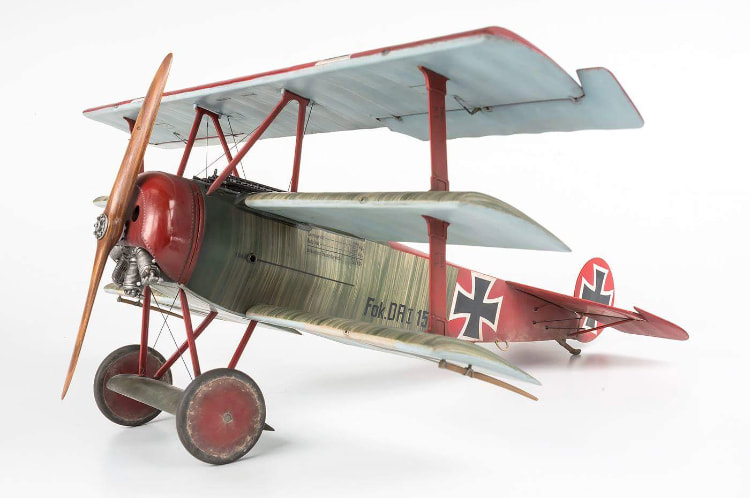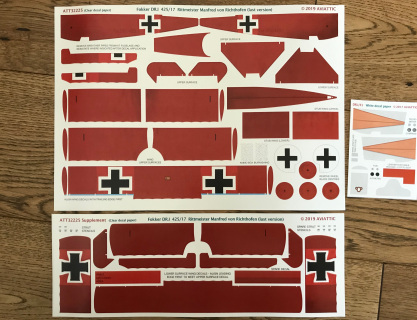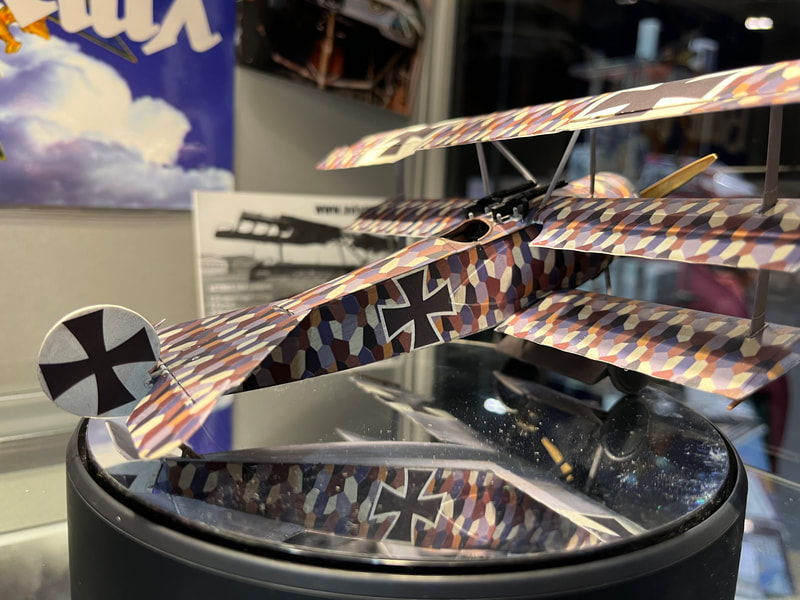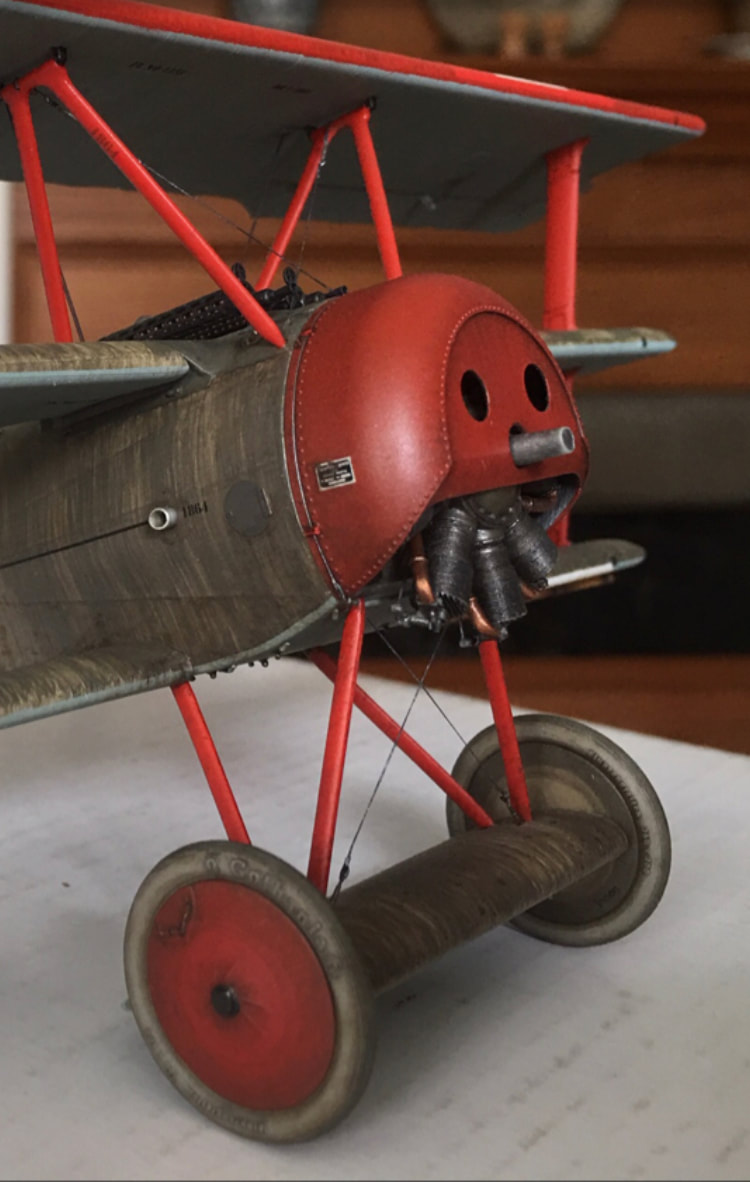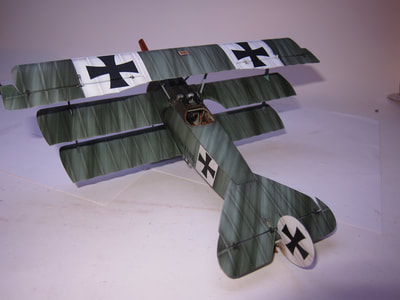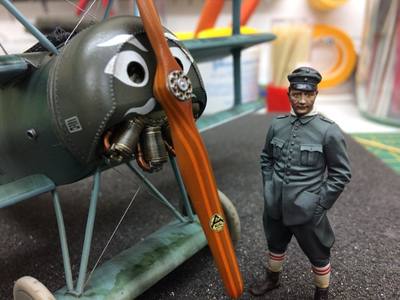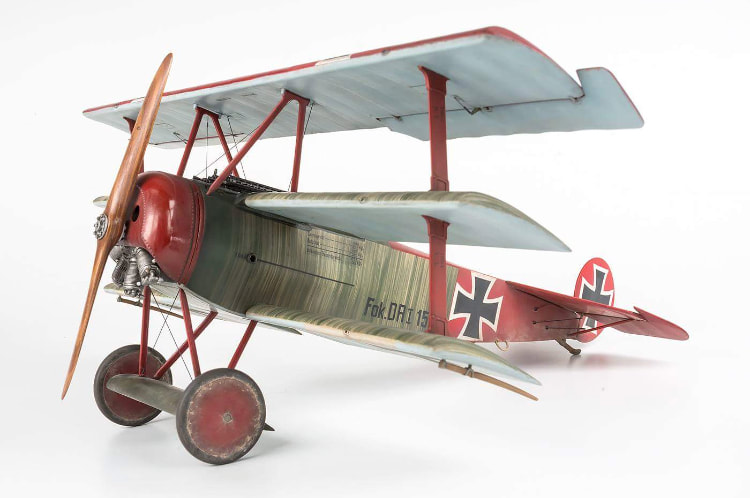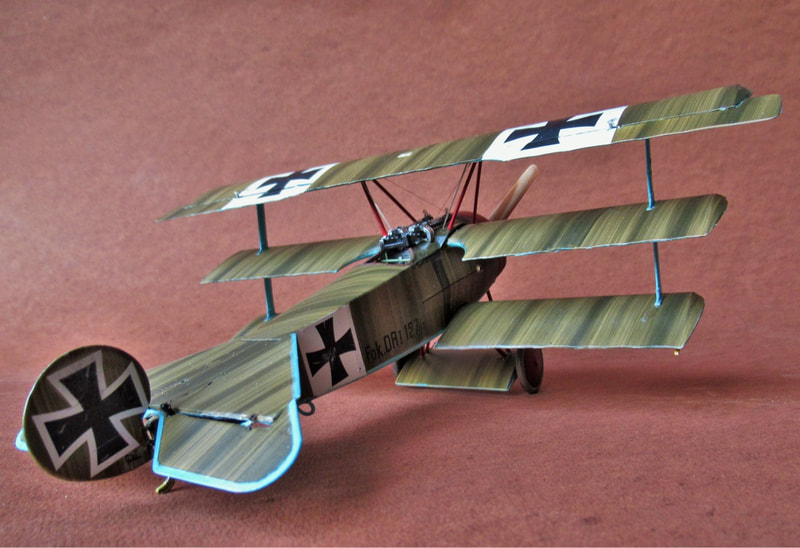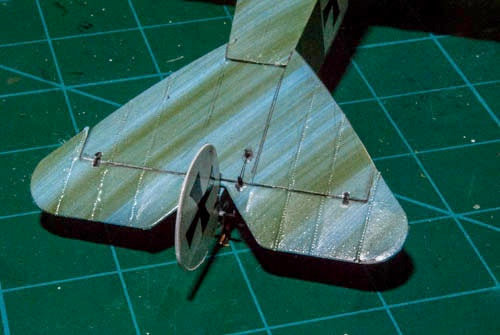Wingnut Wings/Meng kits versions will be released too! Announcement soon.
The remaining four "Rittmeister" sets will be released in September/October 2020.
Designed by Juanita Franzi and myself with colour guidance from Alan Toelle.
All sets include "upper" and "lower" surface decals, interior decals and realistic instrument faces (three sheets in total).
Eight Fokker triplanes are known to have been used by the Baron and the decals replicate the various finishes and colours of these iconic aeroplanes.
Subtle weave effects enhance the illusion of a fabric covered model aeroplane, colours follow our combined thoughts on the original hues with all the most recent theories on these contentious subjects kept in mind.
Changes in the red overpaint effects are due to the underlying materials they were applied over.
White painted national marking fields and the changes made to the insignia, un-primed metal surfaces, varnished wood, doped blue, density of the red oil-based paint all had an effect on the "one red" we are all used to seeing the famous triplanes exhibiting...
Match the paint you use for the metal areas, struts and undercarriage closely to the finished decal applied to your model and varnish-sealed.
ATT32216 (for Roden kit) Fokker F.I 102/17 Rittmeister Manfred von Richthofen & Ltn. Kurt Wolff
One of the three prototype triplanes. 101/17 reserved and flown as a test machine, 102/17 given to Richthofen and 103/17 to Werner Voss.
Pale blue painted linen finish over unbleached, doped linen overall with green streaking applied.
With the lack of tell-tale blue lines along bottom longeron and around the tail surfaces indicative of blue painting on undersurfaces only (as the production DR.I later exhibited), along with the description of Voss' machine as "silvery blue", this is how I believe the three prototypes appeared.
Includes interior linen and ply fairing decals, seat cover (to fit Aviattic Fokker seat) and linen baffle, instruments
Tailored to fit the Roden Fokker F.I or Encore re-boxing
It sports a slightly different streaking footprint from 103/17 (later, production DR.I's had rather more defined and heavier streaking patterns and no upper surface underlying pale blue dope).
Under surface national insignia fields are left in doped and varnish sealed natural linen.
These prototypes did not exhibit all the normal part serial numbers.
Flown also by Staffel comrade Ltn Kurt Wolff, who was shot down and killed in this machine on 15th September 1917.
Designed by Richard Andrews and renowned aviation artist Juanita Franzi.
ATT32217 (for Roden kit) Fokker DR.I 114/17 Rittmeister Manfred von Richthofen
Flown briefly by the Baron this aircraft tangled with an errant length of cable on the airfield at Zilverberg on 30/10/17.
Werk nummer 1782
Reference : Blue Max Airmen by Aeronaut Books
ATT32218 (for Roden kit) Fokker DR.I 152/17 Rittmeister Manfred von Richthofen
MvR scored his 64th, 65th and 66th victories in this machine
Reference : Blue Max airmen volume 5 - Aeronaut books
ATT32219 (for Roden kit) Fokker DR.I 525/17 Rittmeister Manfred von Richthofen
This Jasta 6 machine was flown by MvR to visit Jasta 5 at Boistrancourt on 17th March 1918.
Paint cowling black
References : Ace Profiles
Blue Max Airmen - Aeronaut books
ATT32220 (for Roden kit) Fokker DR.I 161/17 Rittmeister Manfred von Richthofen
Flown by MvR to visit Jasta 5 on 21st March 1918 at Boistrancourt.
References : Ace Profiles
Blue Max Airmen - Aeronaut books
ATT32221 (for Roden kit) Fokker DR.I 477/17 Rittmeister Manfred von Richthofen
10 victories scored in this machine between 24th march and 2nd April 1918.
Paint cowling red.
References : Blue Max Airmen - Aeronaut books
The Fokker DR.I - Alex Imrie
Ace Profiles
ATT32222 (for Roden kit) Fokker DR.I 127/17 Rittmeister Manfred von Richthofen (1st version)
First version of the iconic 127/17 features unusual streaking of natural linen covered rudder.
References : Ace Profiles
Blue Max Airmen - Aeronaut books
The Fokker DR.I - Alex Imrie
The Fokker DR.I - Paul Leaman
ATT32223 (for Roden kit) Fokker DR.I 127/17 Rittmeister Manfred von Richthofen (2nd version)
Second version of the iconic 127/17 features thinned red oil paint overpainting and shows a hint of the original green streaking underneath.
References : Ace Profiles
Blue Max Airmen - Aeronaut books
The Fokker DR.I - Alex Imrie
The Fokker DR.I - Paul Leaman
ATT32224 (for Roden kit) Fokker Dr.I 425/17 Rittmeister Manfred von Richthofen (1st version)
The iconic 425/17 is now believed to have been delivered in clear-doped natural linen upper surfaces and doped pale blue below.
Tell-tale sign of the blue undersurfaces practice in DR.I photographs is that the colour was continued onto the bottom fuselage longeron line and bordered the horizontal stabiliser and elevators.
The fact that this is visible indicates to me that blue is not present as an overall base colour on production DR.I's..
The surviving fuselage cross panel of 425/17 shows this blue longeron "edge".
Many of the other relics held in collections and museums across the world show cracked red overpainting on two colours of pale blue (one of the blues has yellowed varnish making it appear "turquoise" - or was it yet another partial over-paint?
Others clearly show no streaking evident under red paint.
One example shows a grey-like streaking colour present but on its own cannot be taken as "proof" of a streaked finish..any triplane relic could gave changed hands at the time or since in the belief it was from the MvR crash scene and may explain some of the anomalies between surviving samples.
425/17's metal parts were delivered in their natural finish - all ready for painting with what could be produced at the front. That exact shade of red paint could have come from many sources. As an oil based paint, most likely thinned and applied more than once, it was either from Jasta stores or a regular household type paint purchased or "acquired" locally.
Many thanks to Juanita Franzi and Alan Toelle for their input into these conclusions.
References : Ace Profiles
Blue Max Airmen - Aeronaut books
The Fokker DR.I - Alex Imrie
The Fokker DR.I - Paul Leaman
Photographs furnished by Greg van Wyngarden
ATT32225 (for Roden kit) Fokker Dr.I 425/17 Rittmeister Manfred von Richthofen (last version)
The iconic 425/17 is now believed to have been delivered in clear-doped natural linen upper surfaces and doped pale blue below.
Tell-tale sign of the blue undersurfaces practice in DR.I photographs is that the colour was continued onto the bottom fuselage longeron line and bordered the horizontal stabiliser and elevators.
The fact that this is visible indicates to me that blue is not present as an overall base colour on the upper surfaces of production DR.I's..
The surviving fuselage cross panel of 425/17 shows this blue longeron "edge".
Many of the other relics held in collections and museums across the world show cracked red overpainting on two colours of pale blue (one of the blues has yellowed varnish making it appear "turquoise" - or was it yet another partial over-paint?
Others show no streaking evident under red paint.
One example shows a grey-like streaking colour present but on its own cannot be taken as "proof" of a streaked finish..any triplane relic could gave changed hands at the time, or since, in the belief it was from the MvR crash scene and may explain some of the anomalies between surviving samples.
425/17's metal parts were delivered in their natural aluminium finish - all ready for painting with what could be produced at the front. That exact shade of red paint could have come from many sources. As an oil based paint, most likely thinned and applied more than once, it was either from Jasta stores or a regular household type paint purchased or "acquired" locally.
Later overpainting of the national markings, to conform with Idflieg directives, has been done rather sloppily. Lines are imperfect and instructions on white border widths have been interpreted "loosely"..particularly the under wing crosses which must have been, clearly, difficult to apply and have a "that will do!.." look to them..
I'm sure Jasta 11 and other front line units had more important things to think about in the Spring of 1918.
Many thanks to Juanita Franzi and Alan Toelle for their input.
References : Ace Profiles
Blue Max Airmen - Aeronaut books
The Fokker DR.I - Alex Imrie
The Fokker DR.I - Paul Leaman
Photographs furnished by Greg van Wyngarden
1/32 Fokker streaking decals and options for the Roden, Wingnut Wings and Special Hobby kits..
Roden DR.I with Aviattic streaking decals and resin cowling!
Model by Martin Lawder
ATT32139 (Clear decal paper) WW1 "streaked" camouflage "Werner Voss Fokker F.I"
Supplied as a clear decal for you to interpret the background colour as you wish
Includes interior linen and ply fairing decals, seat cover(to fit Aviattic Fokker seat) and linen baffle, instruments
Tailored to fit the Roden Fokker F.I or Encore re-boxing
Designed by Richard Andrews and renowned aviation artist Juanita Franzi
ATT32140 (Clear decal paper) WW1 "streaked" camouflage "Werner Voss Fokker F.I" pale blue doped linen
Pale blue painted linen finish over unbleached, doped linen overall with green streaking applied.
With the lack of tell-tale blue lines along bottom longeron and around the tail surfaces indicative of blue painting on undersurfaces only (as the production DR.I later exhibited), along with the description of Voss' machine as "silvery blue", this is how I believe the three prototypes appeared.
Includes interior linen and ply fairing decals, seat cover (to fit Aviattic Fokker seat) and linen baffle, instruments
Tailored to fit the Roden Fokker F.I or Encore re-boxing
Designed by Richard Andrews and renowned aviation artist Juanita Franzi
ATT32141 (Clear decal paper) WW1 German pale blue doped linen "Fokker light"
This sheet is the same pale blue as ATT32140 and is intended for the underside of Voss' iconic Fokker F.I 103/17, a tailored underside set will be announced in November 2017.
ATT32142 (White decal paper) WW1 German pale blue doped linen "Fokker light"
I believe the original three triplane prototypes were painted slightly differently to the later, darker, DR.I production aircraft.
This sheet is the same pale blue as ATT32140 and is intended for the underside of Voss' iconic Fokker F.I 103/17
ATT32143 (Clear decal paper) WW1 'streaked" camouflage Fokker DR.I (+ interior)
Heavier application of the mid-green streaking than the initial three F.I prototypes, with the underneath blue dope carried onto lower longeron edge and horizontal stabiliser, presumably to "tidy up" the brushed dope build-up along these edges.
Interior features unbleached linen and ply fairing detail, instruments (spares of each), linen baffle and cover for the accurate Aviattic "Fokker seat".
ATT32144 (Clear decal paper) WW1 'streaked" camouflage Fokker DR.I on unbleached linen (+ interior)
Heavier application of the mid-green streaking than the initial three F.I prototypes, with the underneath blue dope carried onto lower longeron edge and horizontal stabiliser, presumably to "tidy up" the brushed dope build-up along these edges.
Interior features unbleached linen and ply fairing detail, instruments (spares of each), linen baffle and cover for the accurate Aviattic "Fokker seat".
ATT32145 (Clear decal paper) WW1 German pale blue doped linen Fokker DR.I (lower surface)
The linseed content in the dope varnish, sparingly applied (typical of the "economical" Fokker factory practices) meant that the finish yellowed with age, turning the blue "turquoise" with time.
Whether this occurred during the aircraft's short service life is open to doubt and I believe many historians study of aged and yellowed artefacts has led to the misinterpretation of this colour..
Includes optional undercarriage wing linen covering - or was it just blue-doped ply, which would have given a different effect and colouring than on the flying surfaces...
ATT32146 (Clear decal paper) WW1 German pale blue doped linen Fokker F.I (lower surface)
Tailored to fit the Roden kit.
Samples show an odd mix of both this pale lavender blue, appearing to be a dyed linen, as well as the rather heavier, pigmented dope, sometimes on the same fabric remnant!
Definitive statements regarding this finish cannot be made...
Includes optional undercarriage wing linen covering - or was it just blue-doped ply, which would have given a different effect and colouring than on the flying surfaces...
ATT32059 (Clear decal paper) WW1 Fokker "streaked" camouflage (wings, elevators and ailerons application)
Check your references for your particular subject's camouflage "footprint" - no two aircraft were the same!
ATT32062 (Clear decal paper) WW1 Fokker "streaked" camouflage on unbleached linen (fuselage, turtledeck & tail application)
Check your references for your particular subject's camouflage "footprint" - no two aircraft were the same!
ATT32063 (Clear decal paper) WW1 Fokker "streaked" camouflage on unbleached linen (wings, elevators and ailerons application)
Check your references for your particular subject's camouflage "footprint" - no two aircraft were the same!
ATT32144 and ATT32145 Fokker DR.I upper and lower surfaces set (+ interior)
|
Enhance your builds with Aviattic's Fokker seat, Gaspatch Spandaus and Aviattic replacement rudders, seat and cowling..
ATTRES 033 1/32 "Stripped" rudder for Fokker DR.I and DVI3d printed to order, designed by Gerry Mos as a replacement for Roden kit part should you wish to model a damaged or wrecked machine, or simply a part cut-away! Frame and zig-zag bracing was linen wrapped - try simulating or part covering with Aviattic German linen decals over white-primed metal foil.... |
ATTPE012 1/32 scale Fokker F.I photo-etchBrass photo-etch enhancements for the firewall, belly hatch, rudder and elevator control horns, (two) exquisite fuel advance levers for the cockpit, that F.I lower cowling "lip" and much more! Designed by Richard Andrews, Ron Kootje and Gerry Mos |
ATTPE011 1/32 scale Fokker DR.I/D.VI photo-etchBrass photo-etch enhancements for the firewall, belly hatch, rudder and elevator control horns, (two) exquisite fuel advance levers for the cockpit and much more! Designed by Richard Andrews, Ron Kootje and Gerry Mos |
ATTRES 034 1/32 Fokker DR.I/F.I/DVI rudder (for Roden kits)Designed by Richard Andrews and Gerry Mos Cast by Ron Kootje A more accurate rudder for the Roden kits - just add P/E control horn and hinges from the Aviattic set or kit parts. DISCONTINUED |
ATTRES 003 1/32 set Spandau shell shutes (Fokker DR1 type)As seen on von Richthofen's final DR.I (not common to all DR.I's - check your references) Mastered and cast by Ron Kootje |
ATTRES 061 1/32 Fokker Nutz Fokker DR.I control column early production
3d printed
Designed by Gerry Mos
ATTRES 062 1/32 Fokker Nutz Fokker DR.I control column mid production
3d printed
Designed by Gerry Mos
ATTRES 063 1/32 Fokker Nutz Fokker DR.I control column MvR 425/17 field modification
3d printed
Designed by Gerry Mos
ATTRES 064 1/32 Fokker Nutz Fokker DR.I control column late production (also suitable D.VI & EV/D.VIII)
3d printed
Designed by Gerry Mos
ATTRES 066 1/32 Fokker Nutz Fokker F.I control column
3d printed
Designed by Gerry Mos
ATTRES 004 1/32 Fokker DR.I/DVI cowling for Roden kitsModelled accurately for the first time! Replacement for the Roden 1/32 offering, requires small amount of sanding of the kits "chin" to meet the lower edge. A dedicated P/E set for firewall and inspection panel also available https://www.aviattic.co.uk/photo-etch.html Designed by Mike Swinburne OUT OF STOCK |
ATTRES 032 1/32 Fokker F.I prototype cowlingReplacement for the Roden 1/32 offering, requires small amount of sanding of the kits "chin" to meet the lower edge. Modelled accurately for the first time! The dedicated P/E set for lower "lip", firewall and inspection panel is essential to get the correct "look" to the distinctive F.I prototype cowling https://www.aviattic.co.uk/photo-etch.html Designed by Richard Andrews Mastered by Gerry Mos, Ron Kootje and Auke Elsinga Cast by Ron Kootje |
ATTRES 022 WW1 German Fokker Dr.I seat and cushionModelled accurately for the first time - the distinctive "flare" sided Fokker type aircraft seat, with cushion cast separately Scaled from the DR.I Engels (Fokker archive based) drawings, it is fractionally larger than the new Meng/WNW DR.I kit version. |
Gaspatch 1/32 Spandau 08/15 (Mid period) machine guns (Pair)
Exquisite 3D printed Spandaus (pair) from Costas and the team at Gaspatch Models
